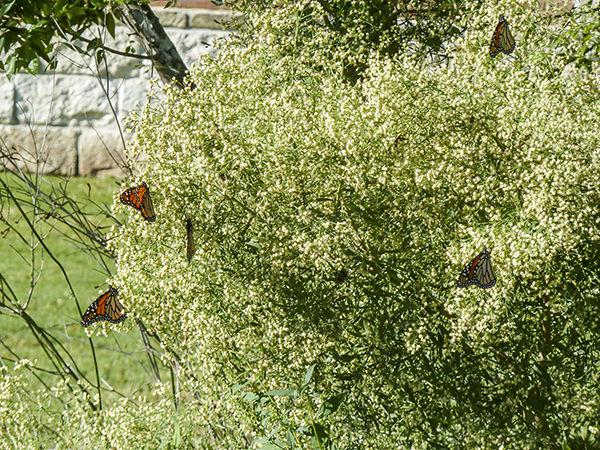After years of plummeting population numbers, there may be a glimmer of hope for the endangered monarch butterfly migration.
Each year, the monarch butterfly leaves Canada and embarks on a migration spanning thousands of miles through the continental United States into Mexico. Even though their numbers have dwindled in the past few years, the butterfly’s population posted a modest comeback in 2015.
The migratory population rebounded by 69 percent this year after an all-time population low in 2014. An estimated 56.5 million monarchs gathered in Mexico for the winter this year.
While the population surge is a positive sign, researchers like Craig Wilson, senior research associate at A&M’s Center for Mathematics and Science Education, caution that factors such as poor farming practices and climate change still need to be addressed if one of North America’s longest migrations is to be preserved.
Wilson said celebrating the monarch’s population surge might be premature.
“The increase from the previous year sounds like a lot, but it was of a population of only 33 million last winter to about 56 million this winter,” Wilson said. “The number has to get much larger to sustain a recovery.”
The monarch’s journey from Mexico to Canada takes six months to complete. The butterflies take pit stops along the way to birth an entirely new generation that will complete the journey. Bryan-College Station falls right on their route.
“About 50 percent of monarchs take this route,” Wilson said. “The others move further to the east but all funnel through Texas first.”
Wilson said weather conditions had improved from last year and allowed the butterflies to migrate south successfully. A typical monarch migration spans three to four generations annually.
“Migratory monarchs live up to nine months while non-migratory monarchs live up to two to three weeks,” Wilson said. “During the spring equinox, monarchs leave their warmer haven in Mexico and begin migrating north to Canada. Along the way, they lay their eggs on milkweed and then die. The third generation of monarchs makes it all the way up north to Canada.”
The existence of milkweed — a plant integral to the monarch’s reproduction and survival — has been threatened for many years now. Monarchs depend on milkweed to rest, birth and dine upon, but extensive pesticide use by the farming community turns milkweed into a toxic breeding ground for the monarch and renders it inhabitable.
Matthew Markert, a biology graduate student researching migratory monarch populations, said Midwestern farmers have been indiscriminately treating their crops with toxic weed killer, causing a drastic decline in milkweed. Another factor responsible for the declining monarchs is climate change.
“Climate change is beginning to shift and shrink environments capable of supporting milkweed,” Markert said. “The increasing urbanization of rural environments, such as mowing and real estate development, contribute to reducing the viable areas that still exist.”
Wilson said an initiative overseen by the U.S. Fish and Wildlife Service will facilitate the monarch’s migration.
“[The initiative] proposes planting about 200,000 acres of Interstate-35 North from Texas to Minnesota with milkweeds to act as a food source and corridor for the migrating monarchs,” Wilson said.
Andrew Payne, history senior, is the founder of the Aggieland Monarch Project. The organization works to encourage Texas A&M to incorporate milkweed and other native pollen-friendly plants into landscape designs. Because B-CS is a through route for the monarchs, Payne said it is imperative for the community to plant milkweed in gardens where the plant is safe from pesticides and landscaping efforts. An abundance of milkweed will yield greater survival rates for the monarch.
“We plan to plant a butterfly garden with lots of milkweed in the plaza between Cushing Library and the Academic Building,” Payne said.
Payne said viewing the monarch population’s decrease as a national issue is accurate, but futile. He said imagining the crisis in such broad terms shifts the responsibility from individual action to national or global powers.
“Instead, let us be concerned with Texas, with the Brazos Valley, with Aggieland,” Payne said. “What can we, Aggies, do to responsibly steward our corner of creation?”
Wilson and his team have been working on planting healthy milkweed and eliminating the spores from parasitic plants, which transfer disease onto an otherwise healthy monarch. Although dangers for the butterfly’s population are imminent, Wilson said he believes the species will not be endangered and, with proper care and attention, could flourish once again.
“[The population surge] is a step, one small step, in the right direction,” Wilson said. “There is a very long, long, long way to go, but it is a positive step.”
Migratory monarch population on the rise
February 18, 2015

PROVIDED
While the monarch butterfly is endangered, researchers remain cautiously optimistic as population numbers increase this year.
0
Donate to The Battalion
Your donation will support the student journalists of Texas A&M University - College Station. Your contribution will allow us to purchase equipment and cover our annual website hosting costs.
More to Discover







